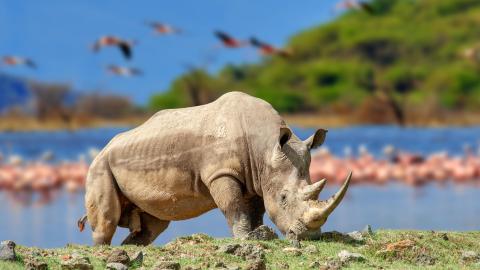- Rhinos were once a highly successful family of mammals that included more than 100 species, most of which have been extinct for more than two million years.
- The evolutionary history of rhinos has long puzzled scientists.
- New research has solved a longstanding debate about the lineage of rhinos, while shedding new light on rhinos’ lack of genetic diversity.
Ancient Earth was a better home for rhinoceroses than today’s. After emerging in North America or Eurasia about 55 million years ago, the herbivorous mammals went on to radiate into more than 100 species that roamed Eurasia, North and Central America, and Africa.
Some were quite different from modern species. Hyracodontidae, for example, were a family of hornless rhinos that looked like muscular horses. Metamynodon rhinos seemed to spend much of their time in the water, like hippos. And then there was Paraceratherium, which at 23 feet tall and 33,000 pounds, was one of the largest land mammals to ever walk the planet.
But by the time the Pleistocene epoch began some 2.5 million years ago, the majority of rhinos had gone extinct. By the end of the Pleistocene, about 11,700 years ago, only nine rhino species had survived. Today five species remain, and all are endangered.
Scientists have a decent understanding of why the more recent rhinos went extinct — likely a combination of pre-industrial climate change and poaching. But what has long puzzled biologists is the evolutionary lineage of rhinos.
Since the time of Charles Darwin, there has been debate over how the existing species of rhinos are related to their recently deceased relatives. Biologists have proposed several hypotheses for the lineage of recent rhinos, centering on different factors like geography or horn characteristics. That debate now seems settled.
The evolutionary history of rhinos
A recent study — published in the journal Cell — analyzed a genome dataset of eight rhino species, including all extant species and three extinct ones. The extant species included the Indian rhinoceros, white rhinoceros, black rhinoceros, Sumatran rhinoceros, and the Javan rhinoceros, while the extinct species included the Siberian unicorn, Merck’s rhinoceros, and the woolly rhinoceros.
The goal was to compare the genomes of living species with recently extinct species in order to establish their evolutionary lineage. The results showed that a divergence occurred among rhinos about 16 million years ago, leading them to evolve into two distinct lineages on the African and Eurasian continents. This geographically based split helped shape the evolution of the rhinos still alive today.

The researchers suggested that the formation of the Gomphotherium land bridge, which connected Africa and Eurasia about 19 million years ago, might have facilitated their ancestral divergence.
“We hypothesize that this land bridge enabled dispersal events followed by vicariance, as is well documented with the immigration into Africa from Eurasia of early rhinocerotids, giraffids, suids, and viverrids and the emigration from Africa to Eurasia of apes, deinotheres, and elephantoids, among others,” they wrote.
Rhino genome diversity
The results also shed light on biological diversity among rhinos. Although rhinos were once biologically diverse, the surviving species are remarkable for their low genetic diversity. The study found that this lack of diversity is not exactly new: rhino populations seem to have been slowly but steadily declining over the past two million years.
“This may be positive news for conservation, since it implies that recent declines may have had less impact on the genetic aspects of population viability than previously thought,” the researchers wrote.
In other words, restoring dwindling rhino populations without causing health problems seems possible. Still, the researchers added that human development and poaching have exacerbated population decline among rhinos. Today, fewer than 30,000 rhinos are estimated to roam the wild, while Indonesia’s Ujung Kulon National Park houses the last remaining wild Javan rhinos on Earth.
“A major priority for rhinoceros conservation will be to halt illegal poaching and ensure that there is sufficient carrying capacity for population recovery,” the researchers concluded.






